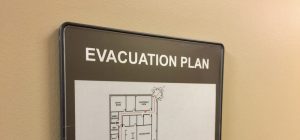Print a Sign-In Sheet | Spanish Version Coming Soon
A plan for a workplace describing what procedures the employer and employees must take to ensure employee safety from fire and other emergencies.
Who is required to have a plan?
- If extinguishers are required or are available, if all employees evacuate during a fire emergency, or if some employees fight fires, but others are evacuated during a fire emergency you must have an emergency action plan.
- If you have a total flooding system with potential health and safety hazards to employees, you must have a plan.
- If you comply with process safety management for highly hazardous chemicals, you must have a plan.
- If you have ethylene oxide, methylenedianiline, 1/3 butadiene, HAZWOPER, or grain handling facilities, you must have a plan.
- OSHA.gov has an eTool to assist with determining if you need a plan.
- If you have 10 or fewer employees, the plan does not have to be in writing. It is based on worksite total, not total employees company-wide.
What type of emergencies should you plan for?
- Reasonably anticipated emergencies such as fire, active shooter, tornado, earthquake, blizzard, etc.
Workplaces need to have procedures for assisting visitors and employees to evacuate, particularly those with disabilities. Take visitor and employee logs so you may account for them.
Special equipment may be needed for the evacuation team.
- High visibility vests;
- Flashlights; and/or,
- Hats.
Minimum Elements of an Emergency Action Plan.
- Means of reporting fires and other emergencies (i.e. calling 911, intercom special code system, pulling fire alarms).
- Evacuation procedures and emergency escape route assignments (primary and secondary routes).
- Procedures for employees who remain to operate critical plant operations before they evacuate.
- Accounting for all employees after an emergency evacuation has been completed.
- Procedures to be followed by employees performing rescue or medical duties (most likely you will rely on the local Fire Department and EMS, but make sure they are aware of this and communicate it to them prior).
- KYOSH requires that if you have eight or more employees at your facility you need to have someone adequately trained in First Aid and CPR.
- The names of employees responsible for providing information or explanations of the plan to other employees (fire/floor evacuation wardens).
Employee Alarm Systems
- An alarm system must be in place and maintained.
- It must have a distinct signal for each purpose.
- It should be perceived over ambient conditions by all employees (distinctive & recognizable).
Refuge Areas
- Need to be designated (good idea to post signs).
- Kept away from windows and exterior walls.
- Be far enough away from the building (100 feet).
Building Evacuations
- While it is not a part of the standard, it is still a good idea to include a workplace map with evacuations routes in the evacuation plan.
- Do not use elevators during an emergency.
- Designate an assembly area.
- Do not make the exit map too complicated.
Exits and Exit Routes
- Do not block them.
- Do not lock them from the inside.
- Mark doors as an emergency exit.
Implementation of the Emergency Action Plan
- Train employees that are in charge of assisting with the evacuation.
- Have one fire evacuation warden for every 20 employees.
- Train all employees on the evacuation & plan.
- Train employees when the plan is initially developed or at new hire.
- Train employees when responsibilities change.
- Train employees when the plan changes.
- Have an annual evacuation drill (may do it more often).
KEMI does not assume liability for the content of information contained herein. Safety and health remain your responsibility. This information is to be used for informational purposes only and not intended to be exhaustive or a substitute for proper training, supervision or manufacturers’ instructions/recommendations. KEMI, by publication of this information, does not assume liability for damage or injury arising from reliance upon it. Compliance with this information is not a guarantee or warranty that you will be in conformity with any laws or regulations nor does it ensure the absolute safety of any person, place or object, including, but not limited to, you, your occupation, employees, customers or place of business.

